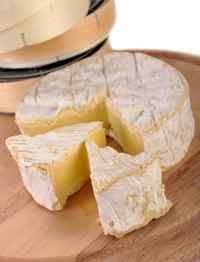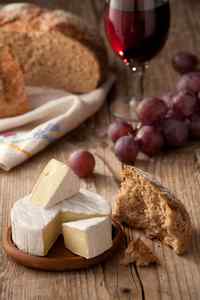Camembert Cheese de Normandie
French Camembert cheese is made in the Pays d'Auge in the departments of Calvados, Manche, Orne and Eure. This region enjoys an oceanic climate, with fairly even year round temperatures and lots of rain. These conditions have created an abundant and varied grass land, perfect for grazing dairy cows and producing rich and nourishing Camembert de Normandie.
Origin and History
The makers of this French cheese tell the story of how it was first created in 1791 in the town of Camembert in Normandy. This was the time of the French Revolution and Marie Harel had given refuge to a priest who came from the town of Brie near Paris. According to the legend, it was he who let her in on the secrets of great cheese making in the Brie fashion. Hence the similarity between the two cheeses. Of course, in a land of happy cows, the Normans had been making cheese for many centuries and surely Madame Harel can only be part of the true history.
Camembert cheese is a fairly delicate product and it took the invention of the emblematic balsa wood box in the late 19th century to seal its fate as one of France's favorites. This special box, which is still used today, protects the cheese but also allows it to breath.
In 1983 the cheese was officially sanctioned with an AOC (appellation d'origine contrôlée). In 1996, this appellation was extended to an AOP (appelation d'origine protegée), the European certification of an exceptional product. In order to be labeled Camembert de Normandie a cheese must be made in a strictly controlled fashion. Most importantly it must be made with raw (unpasteurized) cow's milk produced in the Normandy region.
Description

- Milk. AOC Camembert cheese is made with unpasteurized milk. Non-AOC Camembert is more than likely made with pasteurized milk and connoisseurs can taste the difference.
- Rind. The white bloomy rind of this soft cheese is made by a tiny white fungus, called penicillium candidum. It is meant to be eaten with the cheese. The rind should not be caved in, nor should it be grey or cracked. However, small brown spots and sightly yellow edges are signs of quality.
- Shape. This cheese is molded in small flat cylinders each weighing about half a pound (250 grams).
- Taste. The taste depends on the age of the cheese. When it is young (20 days after it is made), it has a milky, sweet taste. As it ages (30 to 35 days after it is made), the taste becomes fruity and strong.
- Smell. Camembert cheese should smell slightly fruity. As it ripens, this cheese may give off some ammonia smell. This should dissipate by leaving the box open at room temperature for half an hour before enjoying. As it continues aging, the ammonia smell will become even stronger and the cheese will be runny. Some connoisseurs say this is the time to eat it, but most people will tell you that the cheese has gone bad.
- Touch. You may not get the chance to fondle the Camembert before purchasing, but an expert can tell a quality product with a touch. The cheese should be neither too rigid nor too soft.
Camembert in Recipes
This is a great melting cheese, so feel free to try it in various recipes. It marries well with almonds, apples, Calvados, cranberries, honey, red currant jam, roasted garlic, rosemary, thyme and walnuts.
- Appetizers. Wrap phyllo dough around small cubes of cheese and bake. Or for a simple and popular appetizer, bread and deep fat fry cubes of cheese. Serve with sweet and sour dipping sauces.
- Baked. One of the most popular ways to enjoy Camembert cheese is to bake it in the oven and serve as a simple fondue. Cut off the top of the rind and serve with chunks of bread as an appetizer, or make a whole meal of it by serving on a plate with a green salad, bread and apples. This can be done in the box, or you can use a special cheese baking dish.
- Croque-Monsieur - Slice it thin and use it in this grilled cheese sandwich recipe.
- En Croute. Another popular recipe that can be served as an appetizer or a starter course is to wrap the cheese in puff pastry and bake. Follow this baked brie recipe.
- Omelette, souffles, quiches, and terrines. Slice it in small cubes and use it in any of these recipes that call for cheese.
- Sauce A simple cheese sauce can be made by melting cubed Camembert cheese with a cup of cream and seasoning with salt, pepper and mustard.
Crazy for Camembert
Alain Favris a Norman candy maker had the idea to cover pieces of Camembert cheese in chocolate and call them les diamants normands, or Normandy diamonds. Not for the faint of tongue I imagine. Camembert ice cream has seen the day as well.
Return to French Cheese.
Buying
Since it is not pasteurized, you will have a hard time finding Camembert de Normandie outside of France. The pasteurized version, labeled just Camembert, is more easily found, and in fact many countries produce what they call Camembert.
Look at the expiration date on the cheese. If there is still a month before it expires, the cheese is a youngster and should have a light and fresh flavor. Twenty days before the expiration date, the cheese should be soft and have developed some flavor. Ten days before and the cheese will be oozy and have a very pronounced taste.
In my online cheese store you can buy Camembert.
Storing
Camembert cheese should be stored at about 8°C (46°F). Which is to say, not in the refrigerator and not in the cupboard. Do you happen to have a cellar? Otherwise, keep it in the warmest part of the fridge, usually below in the vegetable keeper. Store the cheese in its wooden box and don't wrap it in plastic - you will suffocate it.
Serving

Temperature. Take the cheese out of refrigeration about 1 hour before serving. Ideally it should be enjoyed at 18°C (64°F).
Wine. Avoid high tannic wines which may bring out a bitter flavor. Instead try a light and fruity white wine, perhaps something from Alsace: a gewurztraminer or a riesling, or a low tannic red, Chinon for example. You can also skip the wine all together and enjoy your cheese like the Normans - with a glass of cider or even Calvados, the local apple brandy.
Slicing. Slice in wedges, like a pie. In France the cheese is served with a wedge cut out so that guests can gauge the ripeness.
Accompaniments. Multi-grain French bread or even a spice bread, dried fruits or fresh grapes, also jam and honey.

New! Comments
Have your say about what you just read! Leave me a comment in the box below.